ETSI/SAGE
Specification
Version: 1.4
Date: 30th July 2010
Specification of the 3GPP Confidentiality and
Integrity Algorithms 128-EEA3 & 128-EIA3.
Document 2: ZUC Specification
The ZUC algorithm is the core of the standardised 3GPP
Confidentiality and Integrity algorithms 128-EEA3 & 128-EIA3.
3GPP Confidentiality and Integrity Algorithms 128-EEA3 & 128-EIA3.
ZUC Algorithm Specification Version 1.4
page 1 of 18
�
18-06-2010
26-07-2010
27-07-2010
30-07-2010
Document History
Publication
Improvements to C code
Minor corrections to C code
Corrected preface
1.0
1.2
1.3
1.4
3GPP Confidentiality and Integrity Algorithms 128-EEA3 & 128-EIA3.
ZUC Algorithm Specification Version 1.4
page 2 of 18
�
Blank Page
3GPP Confidentiality and Integrity Algorithms 128-EEA3 & 128-EIA3.
ZUC Algorithm Specification Version 1.4
page 3 of 18
�
PREFACE
This specification has been prepared by the 3GPP Task Force, and gives a detailed
specification of the 3GPP algorithm ZUC. ZUC is a stream cipher that forms the heart of the
3GPP confidentiality algorithm 128-EEA3 and the 3GPP integrity algorithm 128-EIA3. This
document is the second of three, which between them form the entire specification of the
3GPP Confidentiality and Integrity Algorithms:
• Specification of the 3GPP Confidentiality and Integrity Algorithms 128-EEA3 &
128-EIA3.
Document 1: 128-EEA3 and 128-EIA3 Specifications.
• Specification of the 3GPP Confidentiality and Integrity Algorithms 128-EEA3 &
128-EIA3.
Document 2: ZUC Specification.
• Specification of the 3GPP Confidentiality and Integrity Algorithms 128-EEA3 &
128-EIA3.
Document 3: Implementors’ Test Data.
The normative part of the specification of ZUC is in the main body of this document. Annex
A, which is purely informative, contains an implementation program listing of the
cryptographic algorithm specified in the main body of this document, written in the
programming language C.
3GPP Confidentiality and Integrity Algorithms 128-EEA3 & 128-EIA3.
ZUC Algorithm Specification Version 1.4
page 4 of 18
�
TABLE OF CONTENTS
1
Introduction ........................................................................................................................7
2 Notations and conventions..................................................................................................7
2.1 Radix...........................................................................................................................7
2.2 Bit ordering.................................................................................................................7
2.3 Notations.....................................................................................................................7
3 Algorithm description.........................................................................................................9
3.1 General structure of the algorithm ..............................................................................9
3.2 The linear feedback shift register (LFSR) ..................................................................9
3.3 The Bit-reorganization..............................................................................................10
3.4 The nonlinear function F ..........................................................................................10
3.5 Key loading...............................................................................................................13
3.6 The execution of ZUC ..............................................................................................14
Appendix A: A C implementation of ZUC ..............................................................................15
3GPP Confidentiality and Integrity Algorithms 128-EEA3 & 128-EIA3.
ZUC Algorithm Specification Version 1.4
page 5 of 18
�
NORMATIVE SECTION
This part of the document contains the normative specification of the ZUC algorithm.
3GPP Confidentiality and Integrity Algorithms 128-EEA3 & 128-EIA3.
ZUC Algorithm Specification Version 1.4
page 6 of 18
�
1 Introduction
ZUC is a word-oriented stream cipher. It takes a 128-bit initial key and a 128-bit initial vector
as input, and outputs a key stream of 32-bit words (where each 32-bit word is hence called a
key-word). This key stream can be used to encrypt the plaintext.
The execution of ZUC has two stages: key initialization stage and working stage. In the first
stage, a key initialization is performed, i.e. the cipher is clocked without producing output
(see section 3.6.1). The second stage is a working stage. In this stage, with every clock tick, it
produces a 32-bit word of output(see section 3.6.2).
2 Notations and conventions
2.1 Radix
In this document, integers are represented as decimal numbers unless specified otherwise. We
use the prefix “0x” to indicate hexadecimal numbers, and the subscript “2” to indicate a
number in binary representation.
Example 1
Integer a can be written in different representations:
a = 1234567890 decimal representation
= 0x499602D2 hexadecimal representation
= 10010011001011000000010110100102 binary representation
2.2 Bit ordering
In this document, all data variables are presented with the most significant bit(byte) on the left
hand side and the least significant bit(byte) on the right hand side.
Example 2 Let a=10010011001011000000010110100102. Then its most significant bit is
1 (the leftmost bit) and its least significant bit is 0 (the rightmost bit).
2.3 Notations
+ The addition of two integers
ab
The product of integers a and b
=
The assignment operator
mod
The modulo operation of integers
⊕ The bit-wise exclusive-or operation of integers
⊞ The modulo 232 addition
a || b The concatenation of strings a and b
3GPP Confidentiality and Integrity Algorithms 128-EEA3 & 128-EIA3.
ZUC Algorithm Specification Version 1.4
page 7 of 18
�
aH The leftmost 16 bits of integer a
aL The rightmost 16 bits of integer a
a <<< k The k-bit cyclic shift of a to the left
a >> 1 The l-bit right shift of integer a
(a1, a2,…, an)→ (b1, b2,…, bn)
It assigns the values of ai to bi in parallel
For any two strings a and b, the presentation of string c created by the
Example 3
concatenation of a and b also follows the rules defined in section 2.2 i.e., the most significant
digits is on the left hand side and the least significant digits is on the right hand side. For
instance,
a=0x1234,
b=0x5678,
c = a||b =0x12345678.
a=10010011001011000000010110100102
aH=10010011001011002,
aL=00000010110100102.
a=110010011001011000000010110100102。
Then we have
Example 4 Let
Then we have
Example 5 Let
Then we have
a >> 1=11001001100101100000001011010012。
Example 6 Let a0, a1, …, a15, b0, b1, …, b15 be all integer variables. Then
(a0, a1, …, a15)→ (b0, b1, …, b15)
will result in bi=ai, 0≤ i≤ 15.
3GPP Confidentiality and Integrity Algorithms 128-EEA3 & 128-EIA3.
ZUC Algorithm Specification Version 1.4
page 8 of 18
�
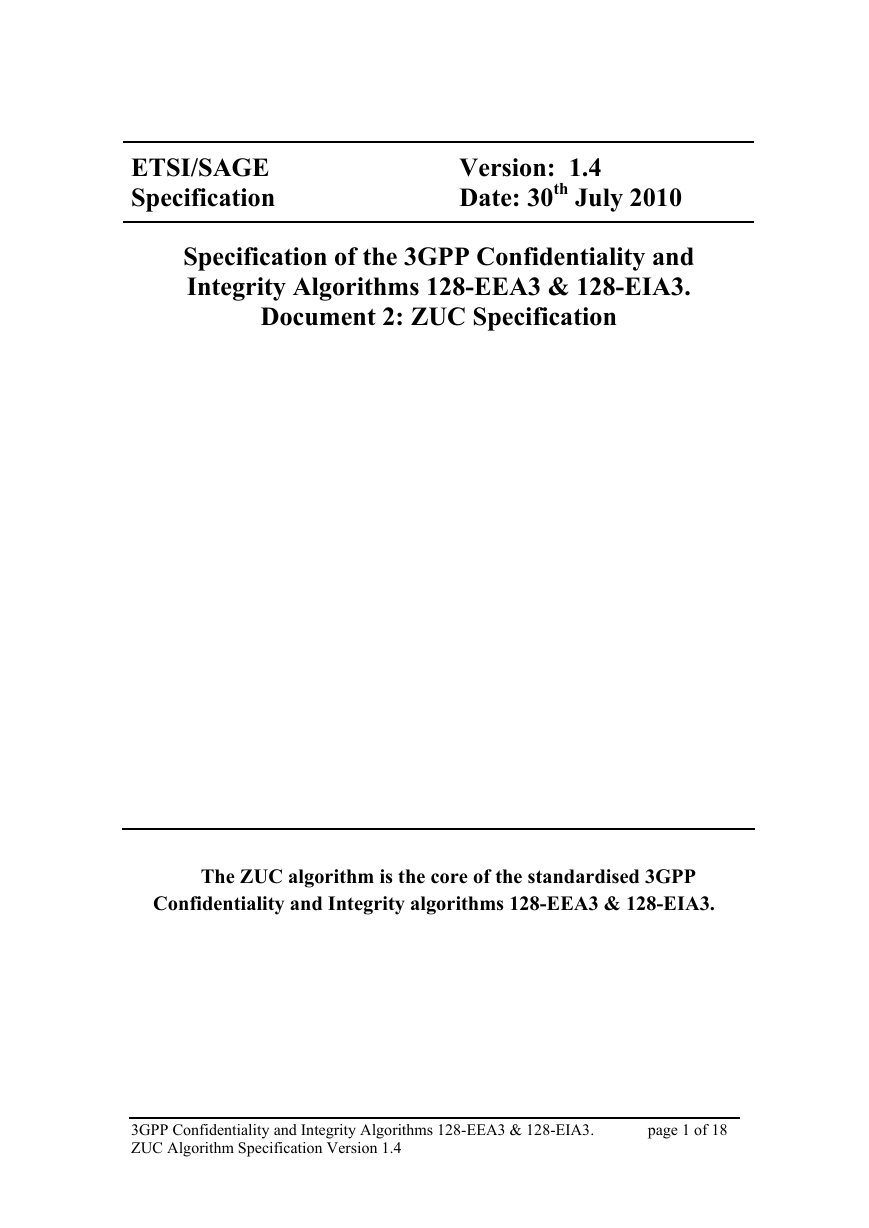
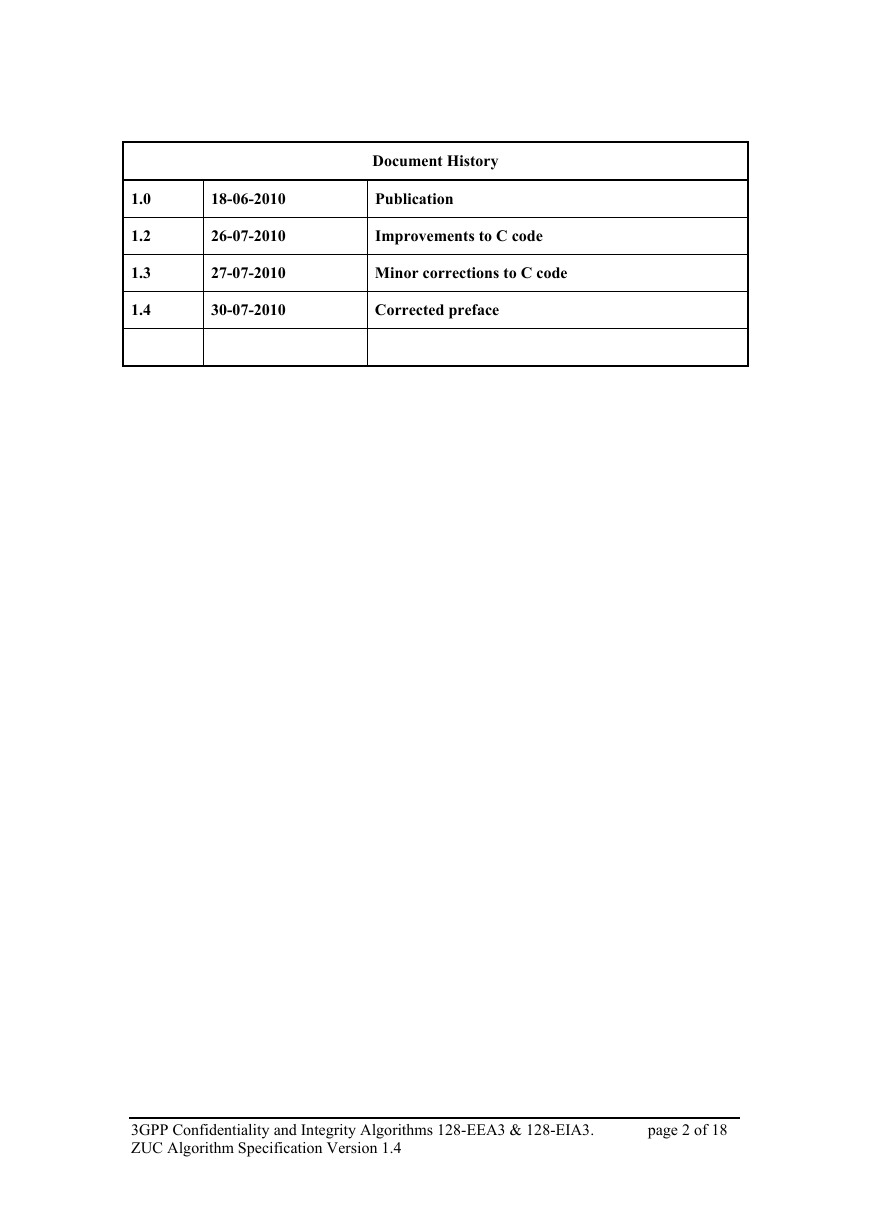

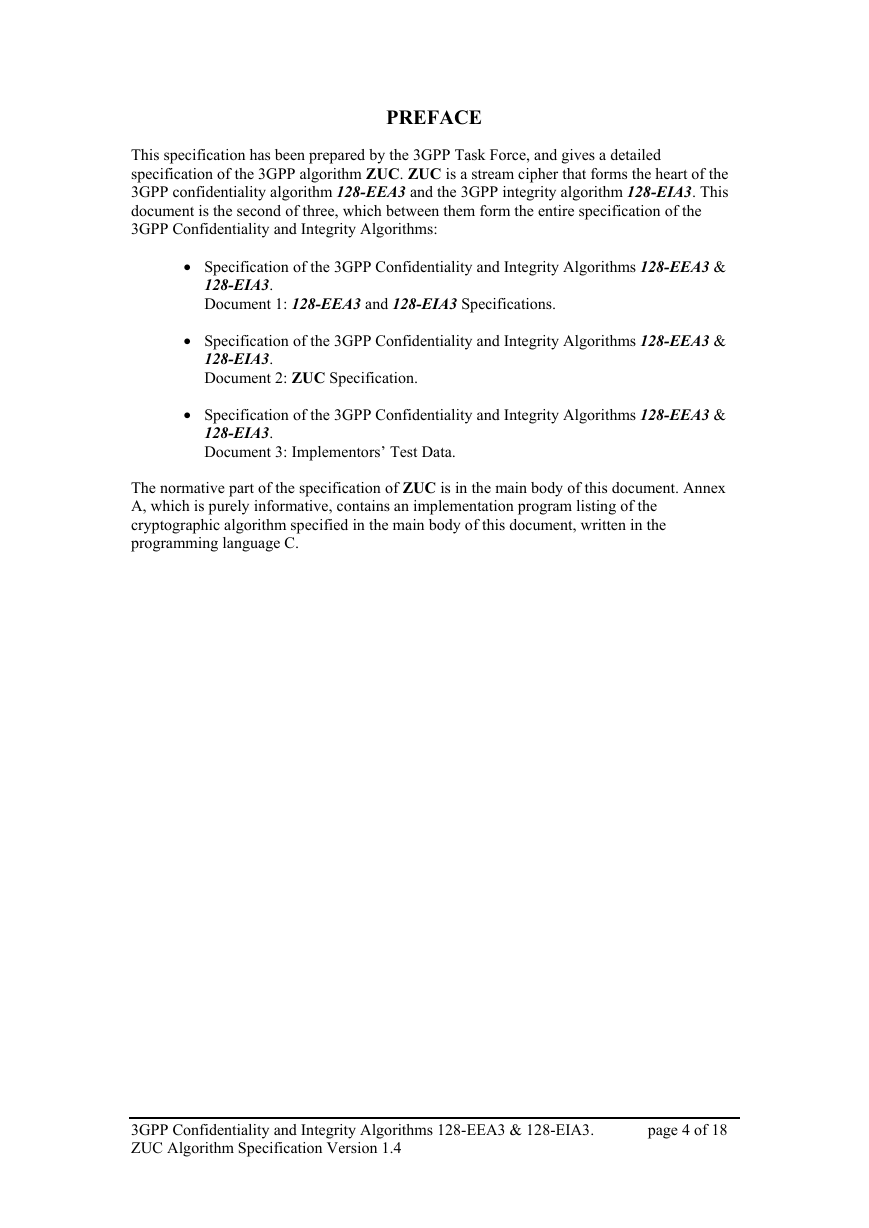
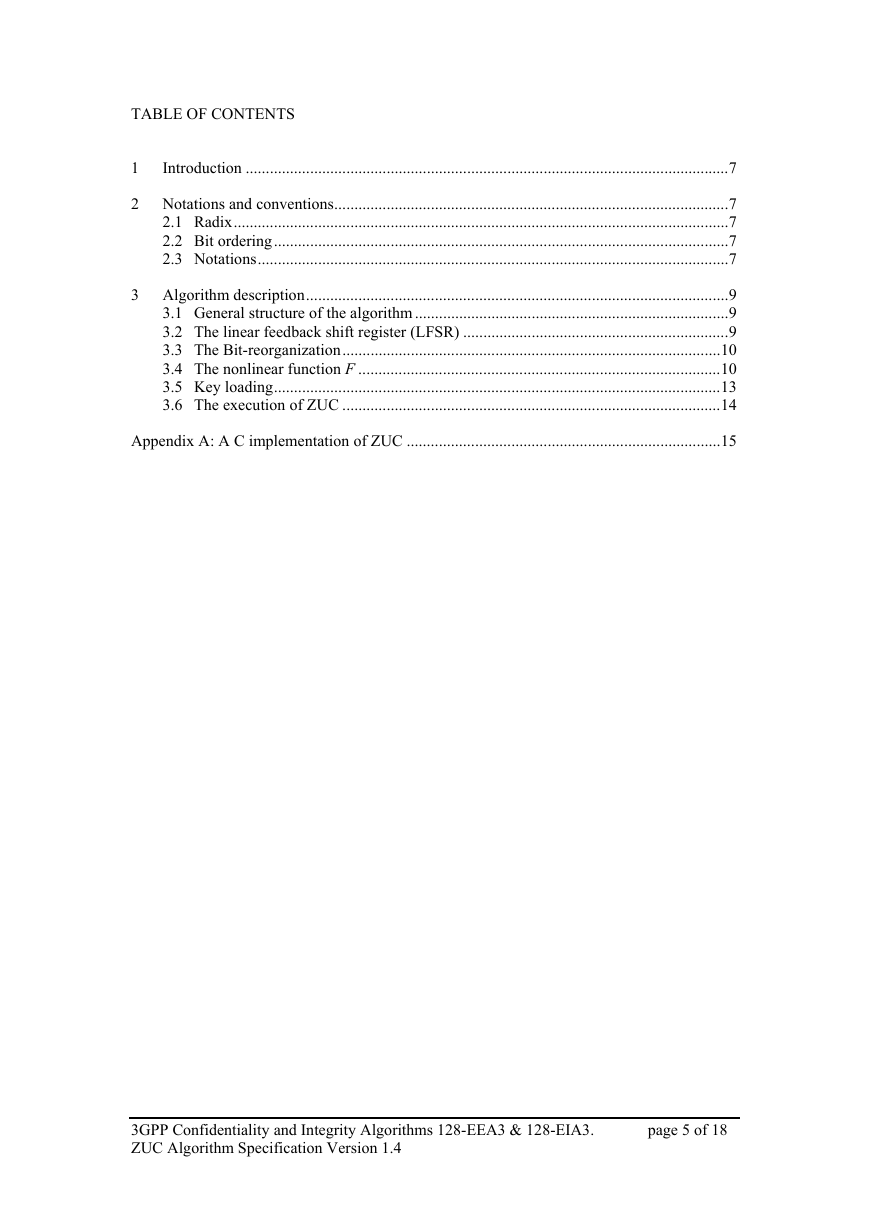
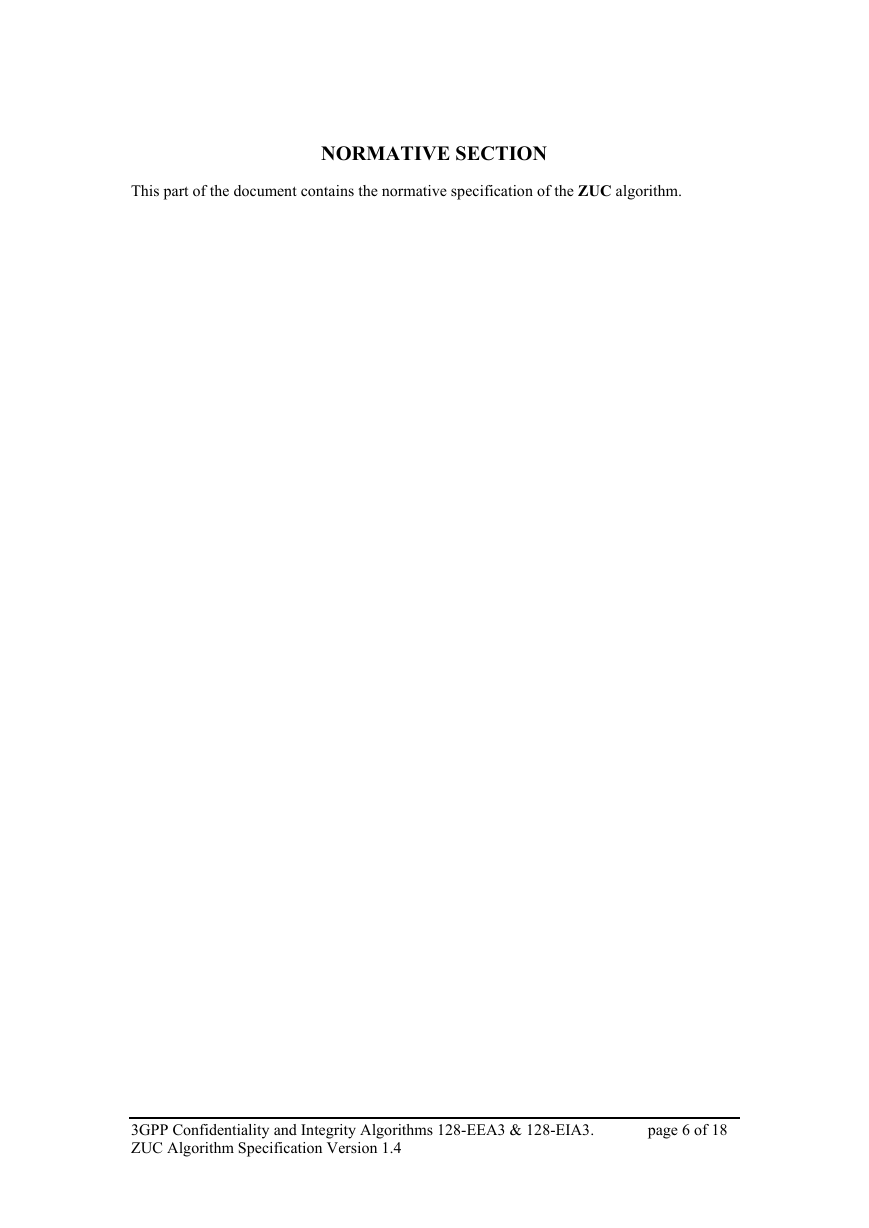
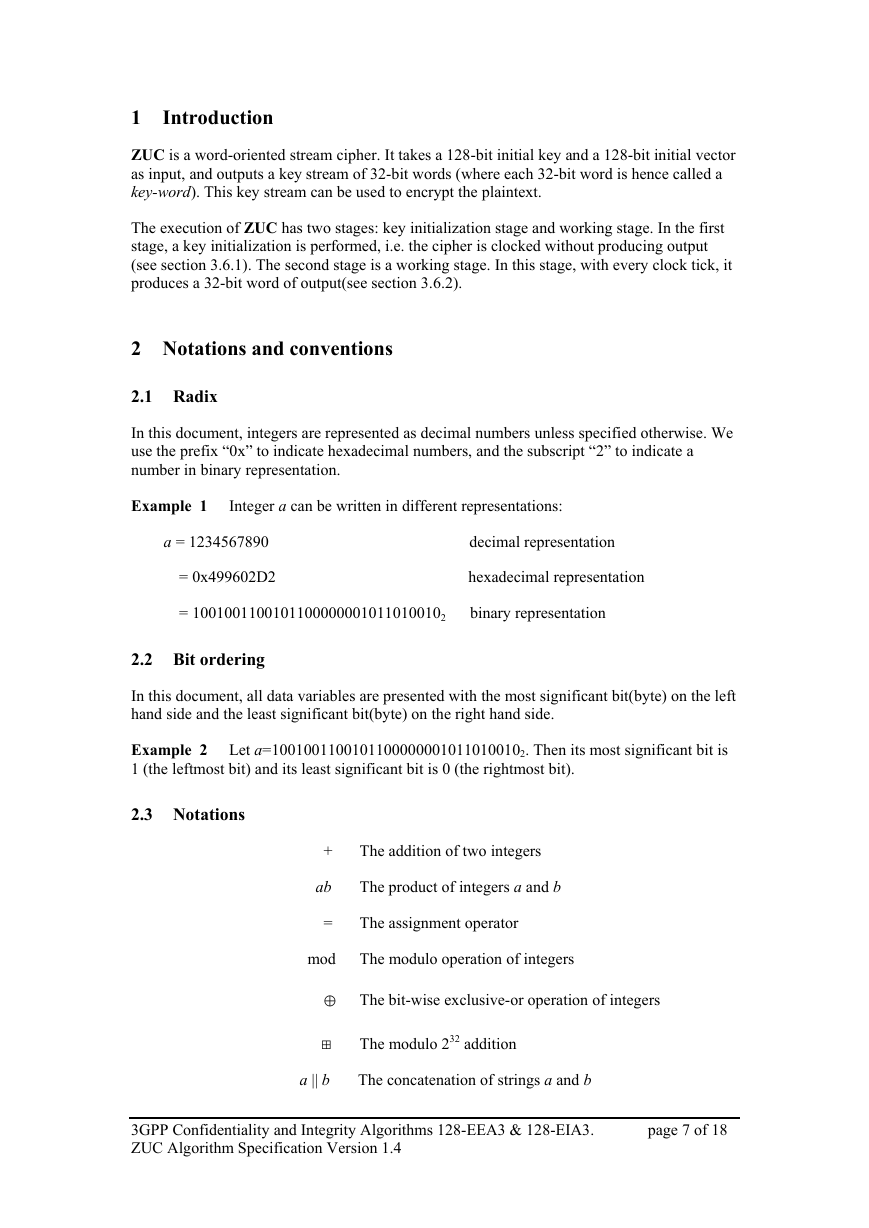
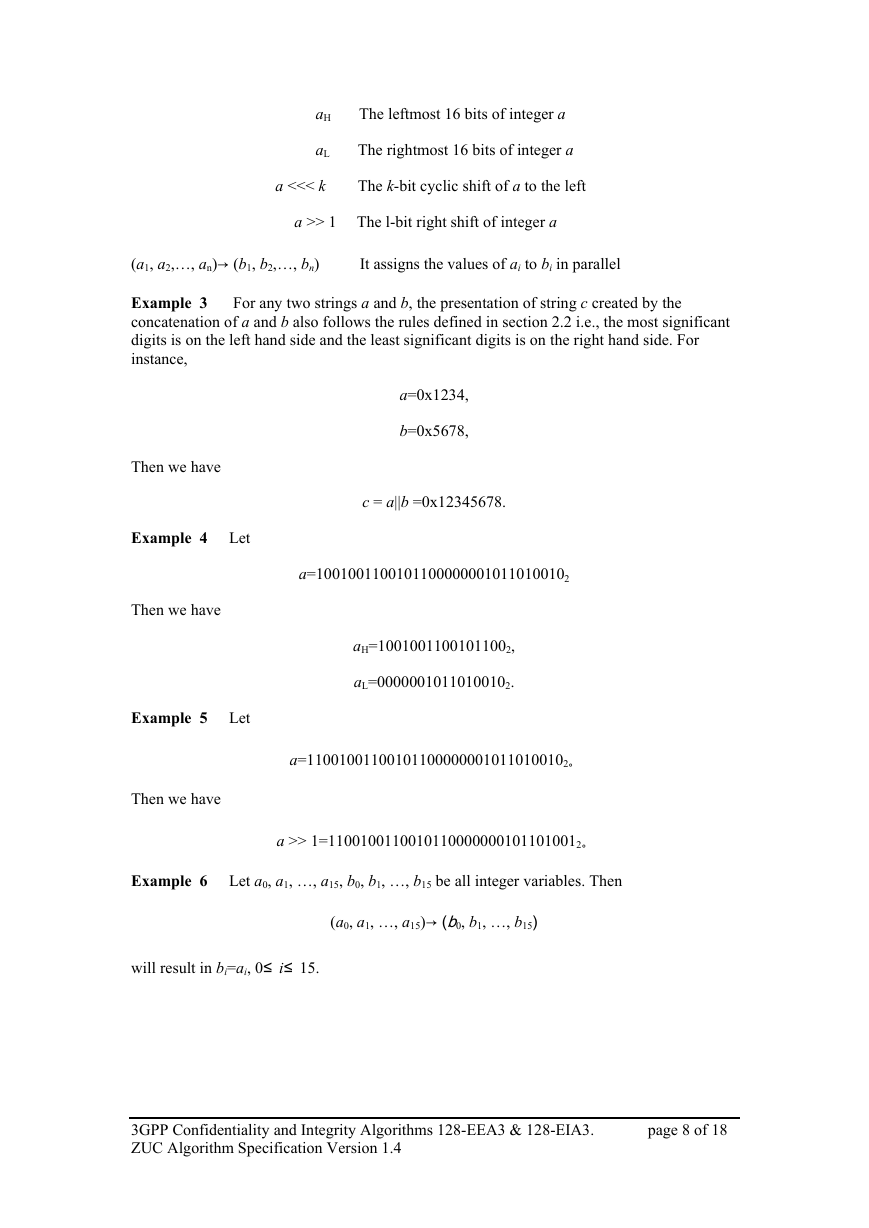








 2023年江西萍乡中考道德与法治真题及答案.doc
2023年江西萍乡中考道德与法治真题及答案.doc 2012年重庆南川中考生物真题及答案.doc
2012年重庆南川中考生物真题及答案.doc 2013年江西师范大学地理学综合及文艺理论基础考研真题.doc
2013年江西师范大学地理学综合及文艺理论基础考研真题.doc 2020年四川甘孜小升初语文真题及答案I卷.doc
2020年四川甘孜小升初语文真题及答案I卷.doc 2020年注册岩土工程师专业基础考试真题及答案.doc
2020年注册岩土工程师专业基础考试真题及答案.doc 2023-2024学年福建省厦门市九年级上学期数学月考试题及答案.doc
2023-2024学年福建省厦门市九年级上学期数学月考试题及答案.doc 2021-2022学年辽宁省沈阳市大东区九年级上学期语文期末试题及答案.doc
2021-2022学年辽宁省沈阳市大东区九年级上学期语文期末试题及答案.doc 2022-2023学年北京东城区初三第一学期物理期末试卷及答案.doc
2022-2023学年北京东城区初三第一学期物理期末试卷及答案.doc 2018上半年江西教师资格初中地理学科知识与教学能力真题及答案.doc
2018上半年江西教师资格初中地理学科知识与教学能力真题及答案.doc 2012年河北国家公务员申论考试真题及答案-省级.doc
2012年河北国家公务员申论考试真题及答案-省级.doc 2020-2021学年江苏省扬州市江都区邵樊片九年级上学期数学第一次质量检测试题及答案.doc
2020-2021学年江苏省扬州市江都区邵樊片九年级上学期数学第一次质量检测试题及答案.doc 2022下半年黑龙江教师资格证中学综合素质真题及答案.doc
2022下半年黑龙江教师资格证中学综合素质真题及答案.doc